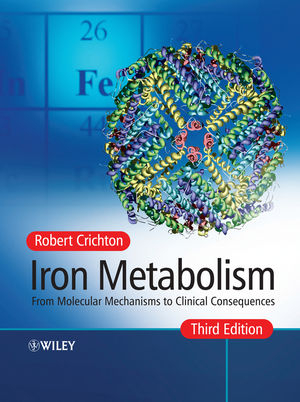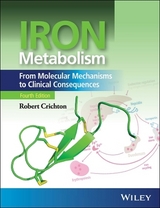
Iron Metabolism
Wiley-Blackwell (Verlag)
978-0-470-01028-0 (ISBN)
- Titel erscheint in neuer
- Artikel merken
Iron is of fundamental importance to the growth, development and well-being of almost all living organisms. Multiple biological systems have evolved for the uptake, utilisation, storage, and homeostasis of iron in microbes, plants and mammals. Both iron deficiency and iron overload are found extensively in humans; the intimate links between iron and oxidative stress are associated with a wide range of pathologies. Iron has a well established role in infections by a range of microorganisms and parasites. Other metals such as copper and zinc are also closely linked with iron metabolism. Iron overloads and deficiencies are important factors in the health of humans and are therefore a key target in drug development. Iron Metabolism: From Molecular Mechanisms to Clinical Consequences, 3rd Edition presents a comprehensive overview of this important field.Topics covered include: Solution chemistry of iron in biological media The importance of iron for biological systems Microbial iron transport and metabolism Iron uptake by plants and fungi Cellular iron uptake and export in mammals Intracellular iron storage and biomineralization Intracellular iron metabolism and cellular iron homeostasis Iron absorption in mammals, with particular reference to man, and regulation of systemic iron balance Pathophysiology of iron deficiency and iron overload in man Iron and oxidative stress Brain iron homeostasis and its perturbation in various neurodegenerative diseases Interactions between iron and other metals Written in a lively style by one of the leaders in the field and presented in full colour, this third, expanded edition of Iron Metabolism has been fully updated with the latest discoveries.
Major additions include recent information on mitochondrial iron metabolism and the role of frataxin; transcriptional control of iron homeostasis; orally active iron chelators; the roles of hepcidin and erythropoietin; the increasing number of types of iron overload; and the importance of iron in Alzheimer's disease. Iron Metabolism is essential reading for researchers and students in biochemistry, molecular biology, microbiology, cell biology, nutrition and the medical sciences. It will also find space on the bookshelves of bioinorganic chemists with an interest in iron metabolism, health professionals with an interest in diseases of iron metabolism, and pharmacologists in the pharmaceutical industry interested in developing novel iron-binding drugs.
Preface. 1. Solution Chemistry of Iron in Biological Media. 1.1 Aqueous Solution Chemistry of Iron. 1.2 Biomineralisation. References. 2. The Importance of Iron for Biological Systems. 2.1 Introduction. 2.2 Physical Techniques for the Study of Iron in Biological Systems. 2.3 Haemoproteins. 2.4 Iron-Sulfur Proteins. 2.5 Other Iron Containing Proteins. 3. Microbial Iron Transport and Metabolism. 3.1 Introduction. 3.2 Siderophores. 3.3 Intracellular Iron Metabolism. 3.4 Control of Gene Expression by Iron. 4. Iron Uptake by Plants and Fungi. 4.1 Iron Acquisition by Plants. 4.2 Iron Acquisition by Yeast. References. 5. Cellular Iron Uptake and Export in Mammals. 5.1 The Transferrins. 5.2 Structure of Transferrins. 5.3 Transferrin Iron Binding and Release. 5.4 Iron Uptake by Mammalian Cells - Uptake of Transferrin Bound Iron. 5.5 Cellular Iron Uptake and Export. 5.6 Uptake of Iron from Other Sources than Transferrin. 5.7 Nontransferrin Bound Iron. 5.8 Ferritin Bound Iron. 5.9 Haptoglobin and Haemopexin as Iron Transporters. References. 6. Intracellular Iron Storage and Biomineralisation. 6.1 Intracellular Iron Storage. 6.2 Biomineralisation. 7. Intracellular Iron Metabolism and Cellular Iron Homeostasis. 7.1 Intracellular Iron Metabolism. 7.2 Cellular Iron Homeostasis. References. 8. Iron Absorption in Mammals, with Particular Reference to Man, and Regulation of Systemic Iron Balance. 8.1 Iron Metabolism in Man: An Overview. 8.2 Sources of Dietary Iron in Man and the Importance of Luminal Factors. 8.3 Iron Losses and Requirements for Absorbed Iron. 8.4 Molecular Mechanisms of Mucosal Iron Absorption. 8.5 Regulation of Iron Uptake by the Enterocyte. 8.6 Regulation of Systemic Iron Balance. References. 9. Pathophysiology of Iron Deficiency and Iron Overload in Man. 9.1 Introduction: Acquired and Genetic Disorders of Iron Metabolism. 9.2 Homeostatic Control of the Internal Milieu and Consequences of Its Disruption. 9.3 Iron Overload Syndromes. 9.4 Primary Iron Overload, Hereditary Haemochromatosis (HH). 9.5 Secondary Iron Overload. 9.6 Iron Deficiency and IDA. 9.7 Anaemia of Chronic Disease. 9.8 Conclusions. References. 10. Iron and Oxidative Stress. 10.1 Introduction to Free Radicals. 10.2 Reactive Oxygen Species (ROS). 10.3 Cytoprotective Enzymes and Antioxidants. 10.4 Ageing and Cytoprotection. 10.5 Oxidative Stress. 10.6 Cyclin Dependent Kinases. 10.7 Deregulation of Calcium Homeostasis and Oxidative Stress. 10.8 Nitric Oxide and Cyclic Guaylate Cyclase. 10.9 Activation of cAMP Dependent PKA. 10.10 Importance of Iron, ROS and RNS in Phagocytic Cells. 11. Brain Iron Homeostasis and Its Perturbation in Various Neurodegenerative Diseases. 11.1 Introduction. 11.2 Mechanisms for Iron Transport into Brain. 11.3 Importance of Iron in the Developing Foetus. 11.4 Iron Uptake and Turnover Within the Brain. 11.5 Importance of IRPs in Brain Iron Homeostasis. 11.6 Brain Iron Speciation. 11.7 Neurodegenerative Diseases. References. 12. Interactions Between Iron and Other Metals. 12.1 Introduction. 12.2 Interactions Between Iron and Essential Metals. 12.3 Iron and Toxic Metals. References. Concluding Remarks. Index.
| Zusatzinfo | Illustrations |
|---|---|
| Verlagsort | Hoboken |
| Sprache | englisch |
| Maße | 198 x 255 mm |
| Gewicht | 1354 g |
| Themenwelt | Naturwissenschaften ► Biologie ► Biochemie |
| Naturwissenschaften ► Biologie ► Genetik / Molekularbiologie | |
| Naturwissenschaften ► Chemie ► Organische Chemie | |
| ISBN-10 | 0-470-01028-2 / 0470010282 |
| ISBN-13 | 978-0-470-01028-0 / 9780470010280 |
| Zustand | Neuware |
| Informationen gemäß Produktsicherheitsverordnung (GPSR) | |
| Haben Sie eine Frage zum Produkt? |
aus dem Bereich



